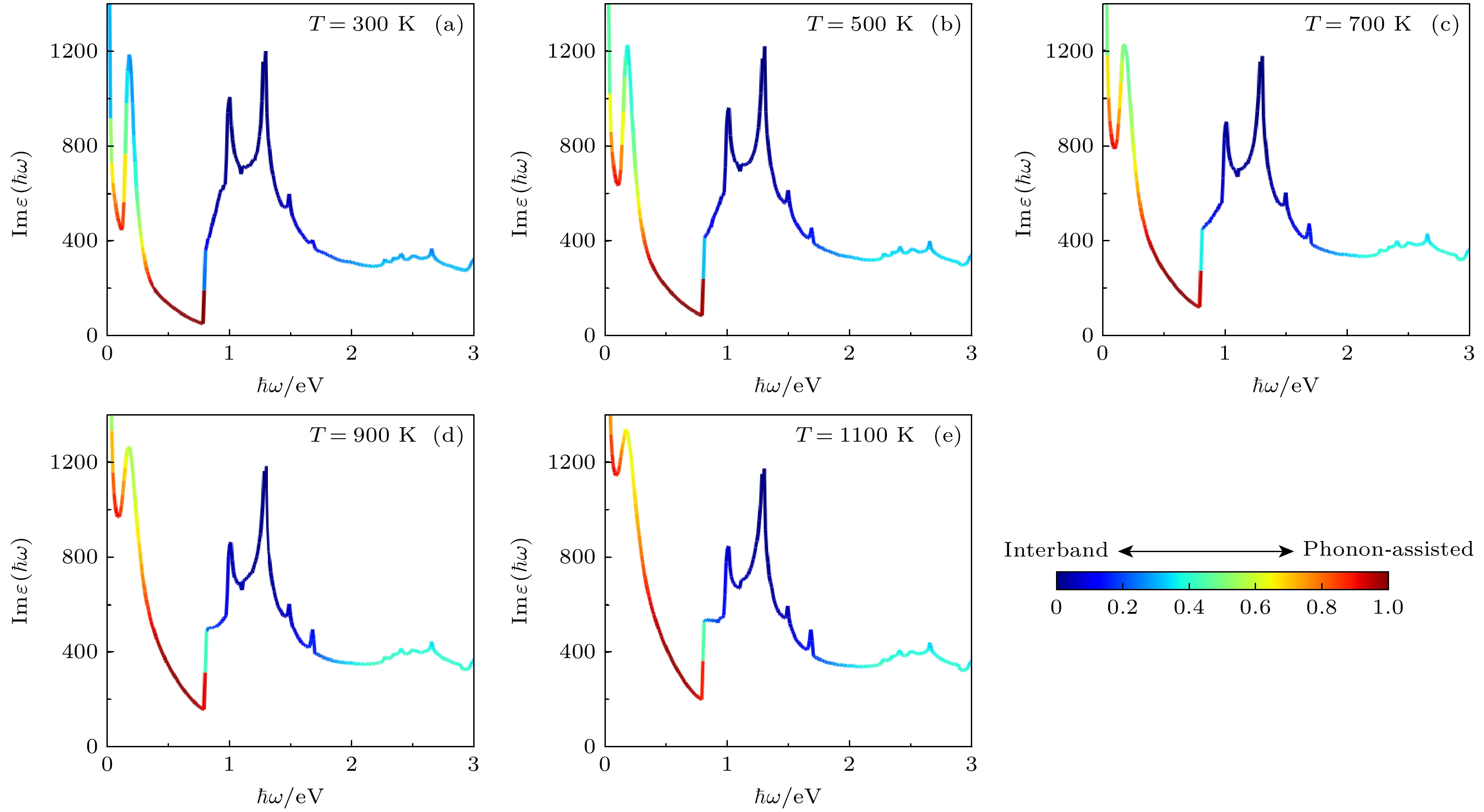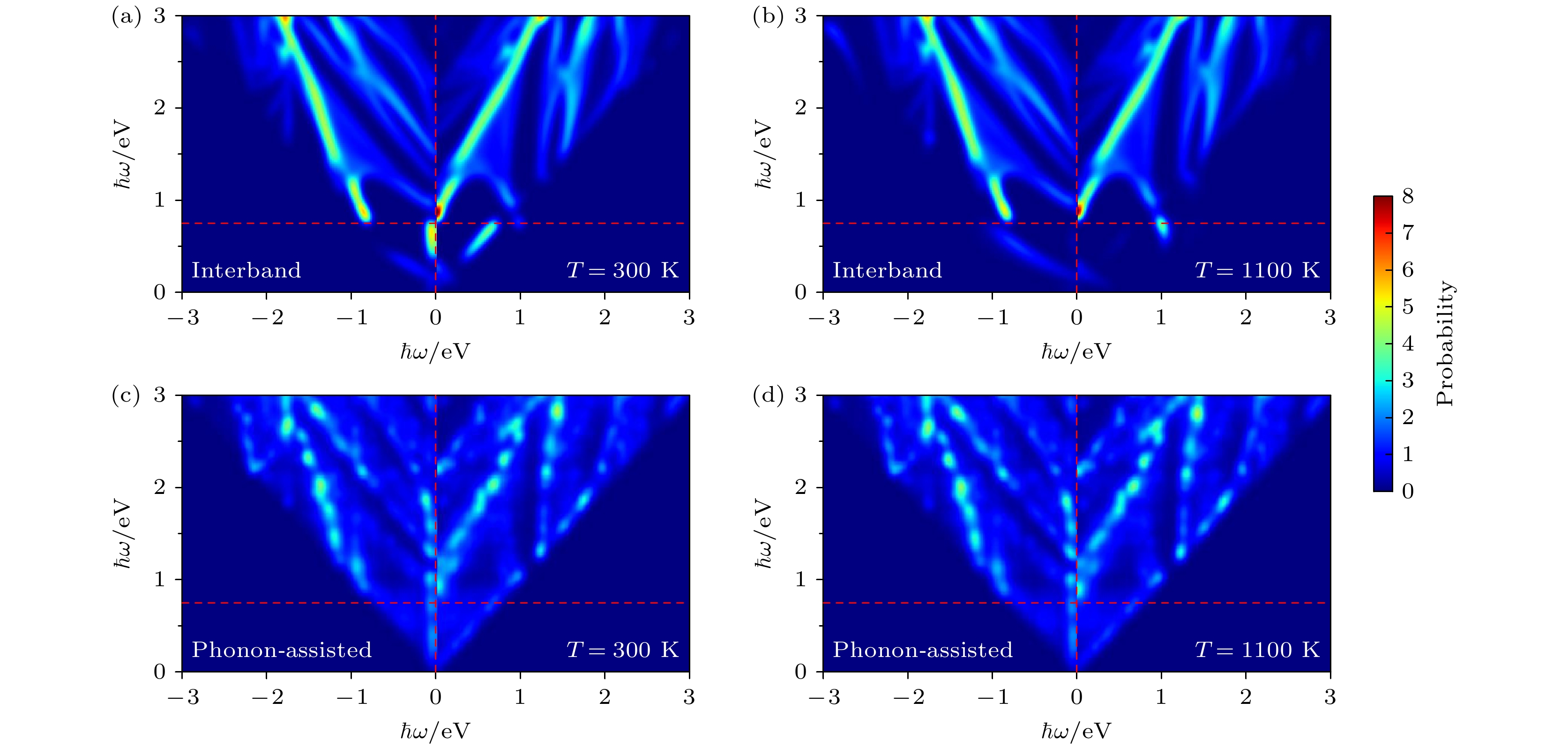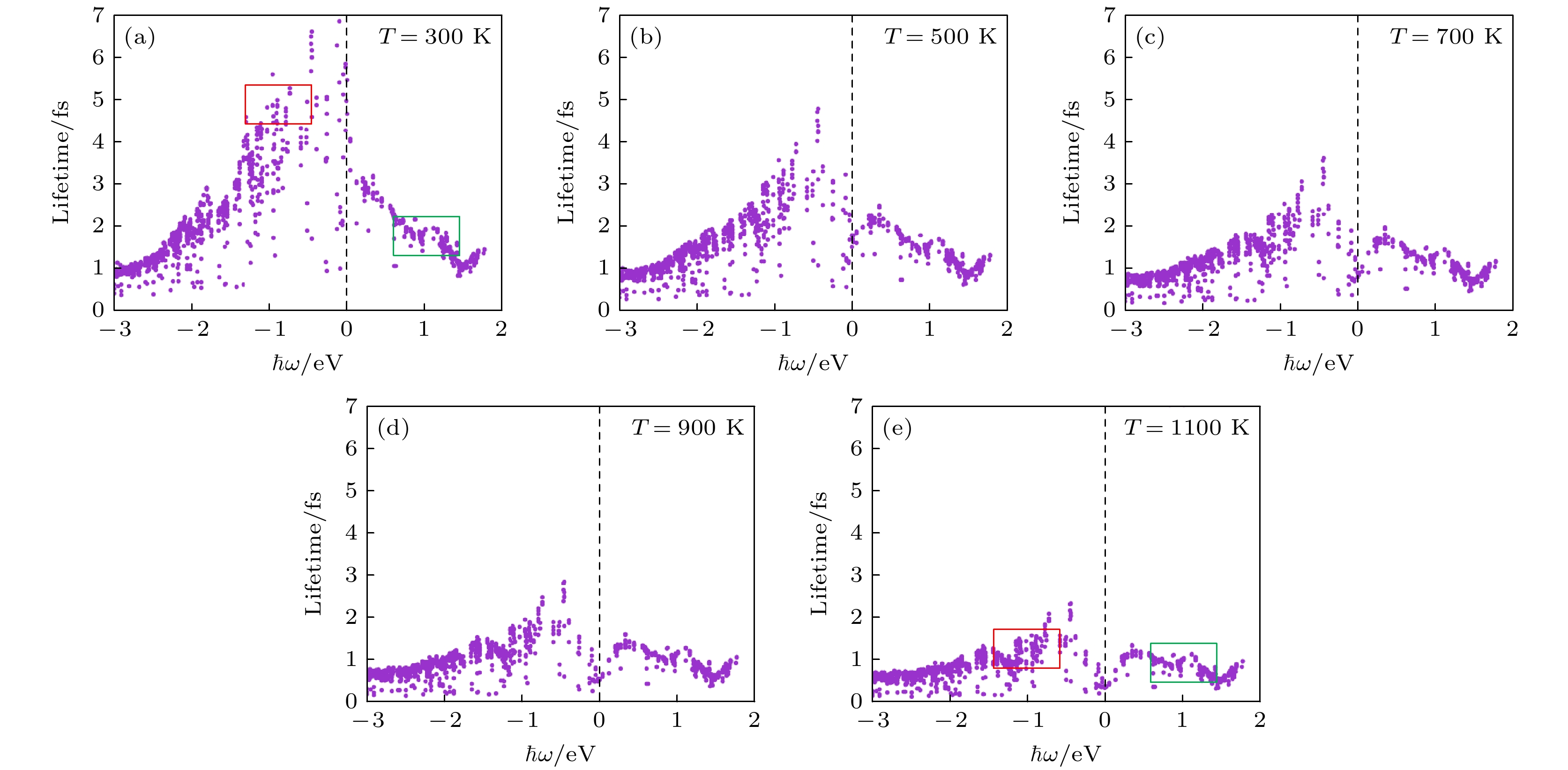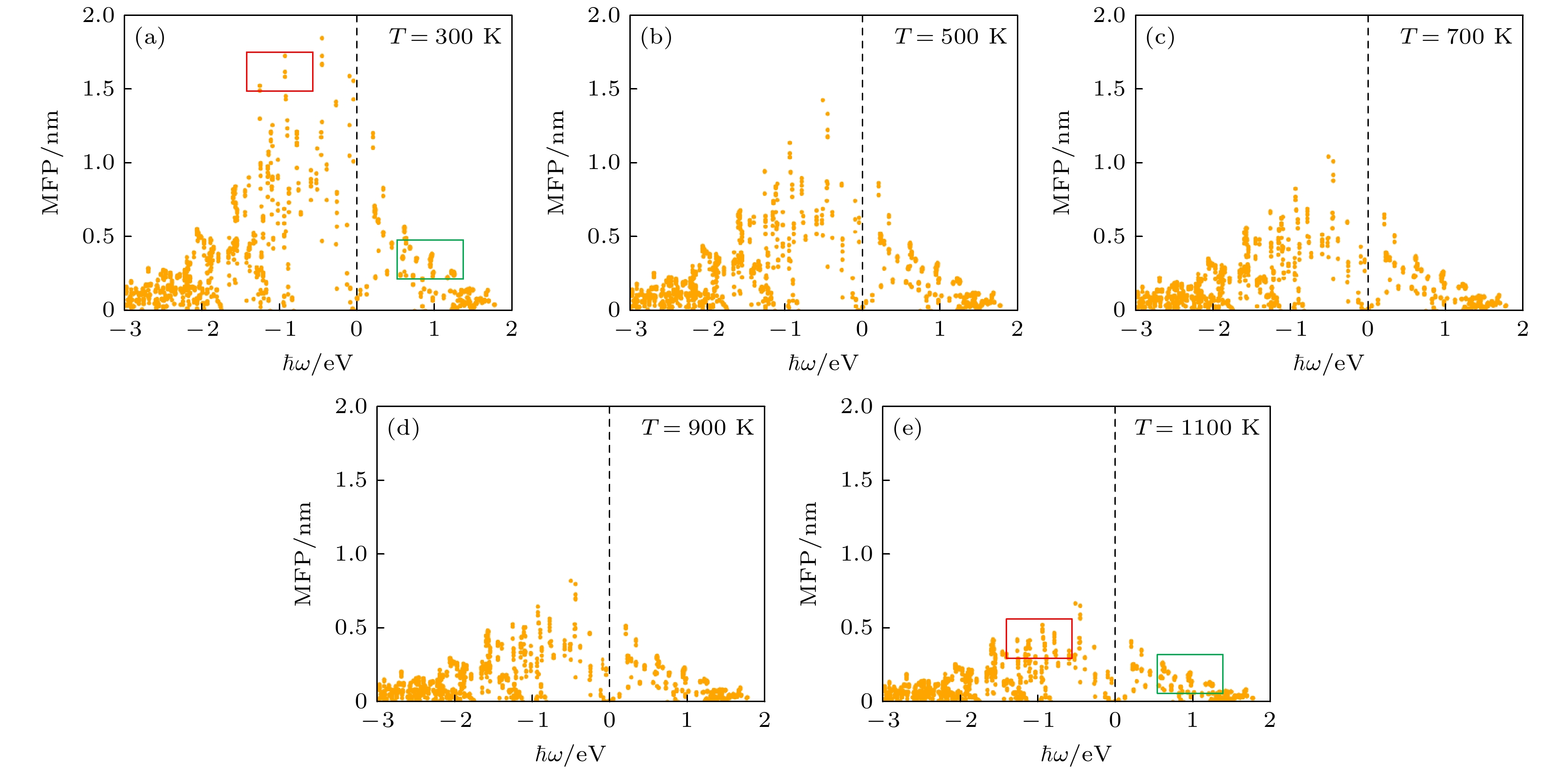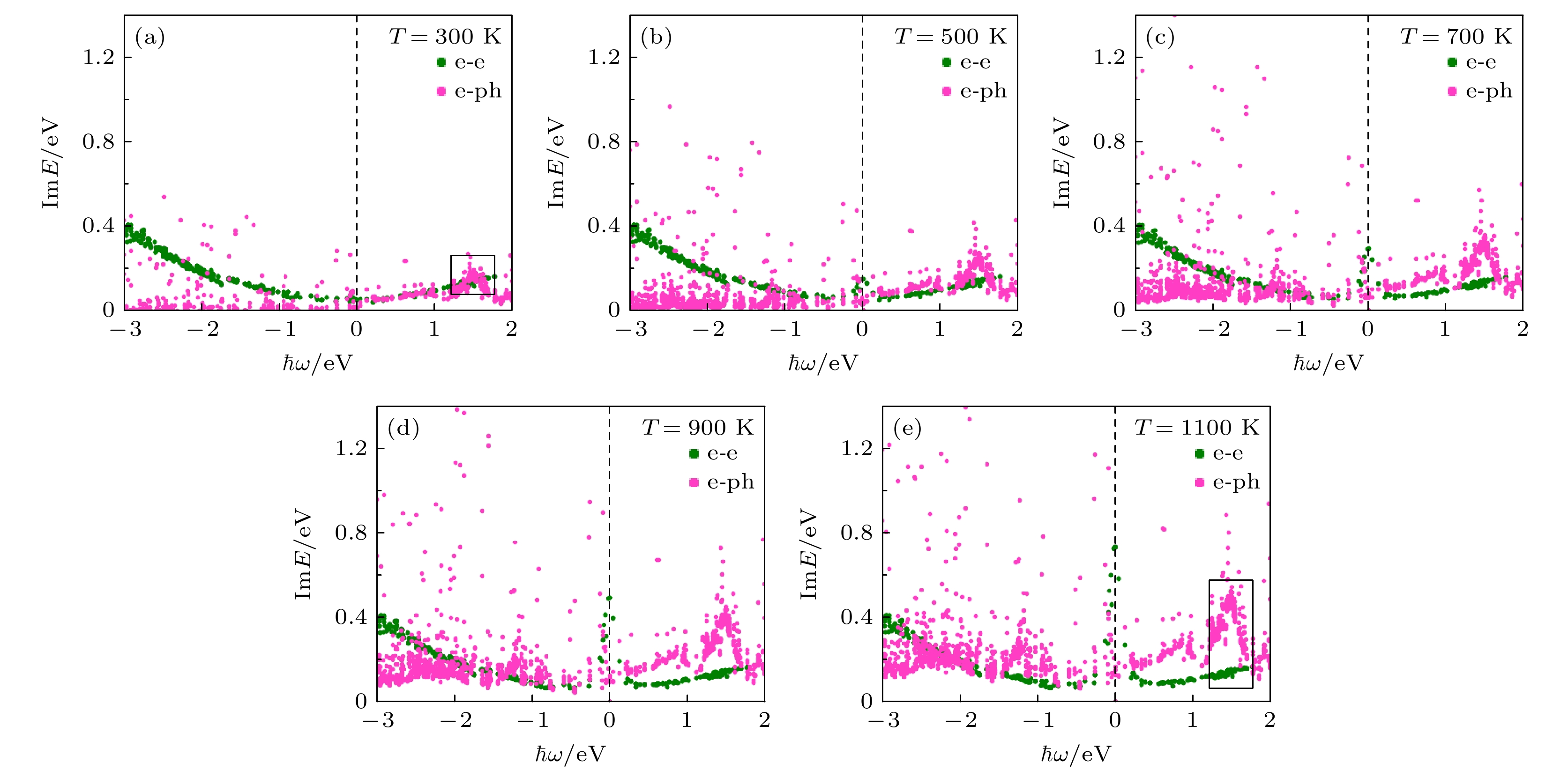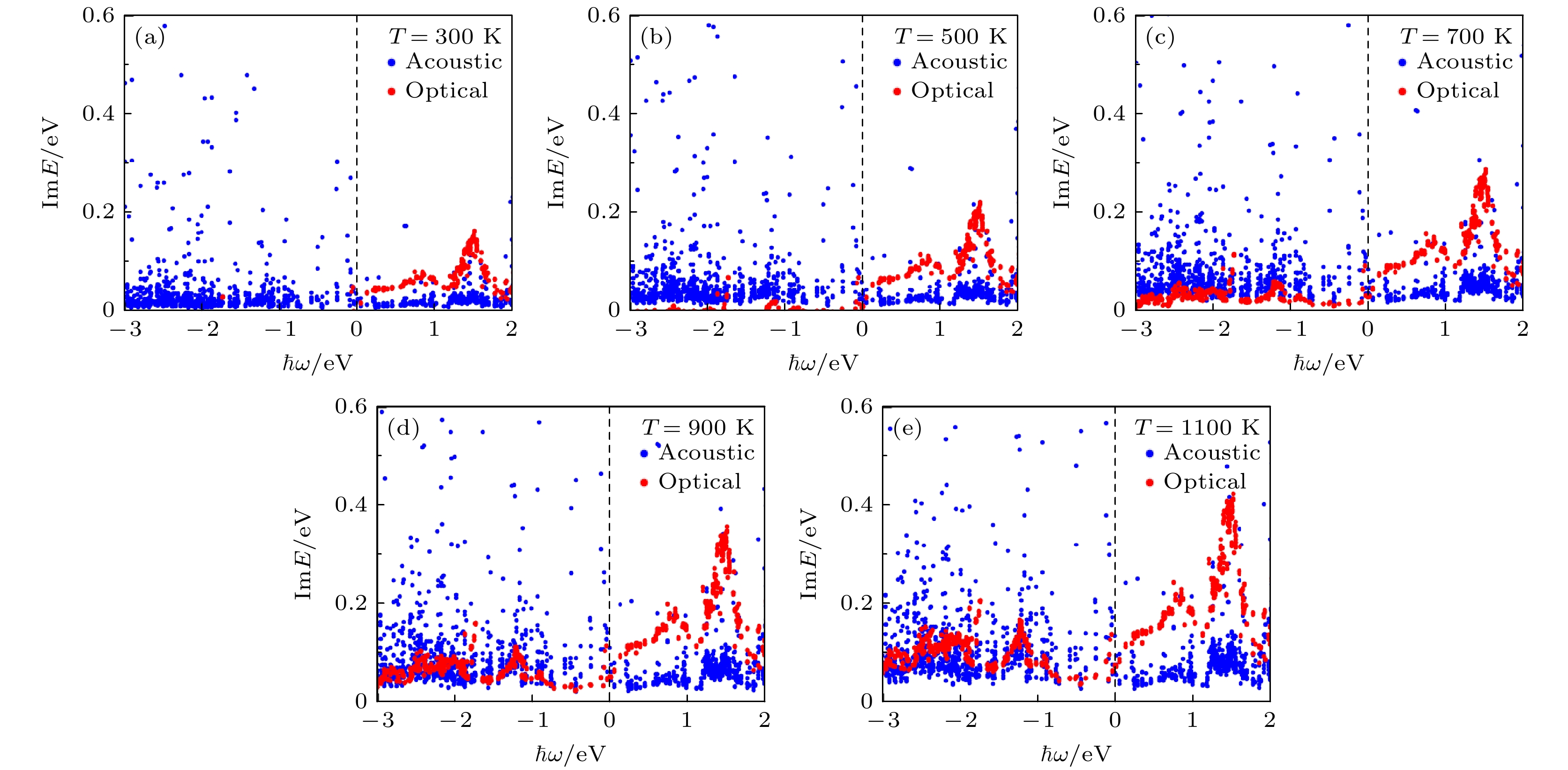-
MXenes 可以实现大规模合成且具有诸多优异光电特性, 被用于构建各种结构和功能独特的热载流子光电探测器件. 然而, 变温环境条件下 MXenes 并不稳定, 一方面环境温度升高会加速材料氧化降解, 另一方面温度变化可能影响光电器件的寿命和性能稳定性, 目前 MXenes 温度不稳定性受到越来越多关注. 鉴于实验研究变温条件下 MXenes 热载流子性质的局限, 本文基于多体微扰理论和量子力学理论, 研究环境温度对电子态分布和散射效应的影响. 从表面等离激元非辐射衰减角度出发, 采用第一性原理计算量化热载流子的产生效率、能量分布和输运, 系统研究了 MXenes 表面等离激元诱导热载流子的环境温度依变特性. 结果表明, MXenes 中带间跃迁和声子协助电子跃迁共同高效率产生了高能热空穴主导的热载流子, 且表现出与硼烯媲美的长寿命和输运距离. 环境温度升高显著提高了红外波段的热载流子产生效率, 同时可见光波段的热空穴表现出优异环境温度稳定性. 此外, 环境温度升高降低了热载流子的寿命和输运距离, 主要源于增强的电子与光学声子散射效应.Unlike conventional optoelectronic devices, plasmon-driven optoelectronic devices can efficiently realize energy conversion and regulate the energy distribution of hot carriers through high-energy, non-equilibrium “hot” electron-hole pairs (hot carriers) generated by surface plasmon non-radiative decay, thereby presenting new opportunities for realizing hot carrier optoelectronic devices. As the basis for the practical application of plasmon optoelectronic devices, searching for plasmon metal materials with exceptional performance has always been an important topic in the field of hot carrier optoelectronic devices. Currently, MXenes can be synthesized on a large scale and has excellent photoelectric properties, so it can be used to build a variety of hot carrier photodetectors with unique structures and functions. Unlike the fixed surface ends of two-dimensional materials such as graphene, MoS2 and borophene, MXenes has an abundance of surface functional groups. However, the increase of ambient temperature will accelerate the oxidation modification of surface functional groups, thus affecting the life and performance stability of optoelectronic devices. In view of the inherent limitations of experimental research on dynamic characteristics of hot carriers at continuous temperatures, we study the temperature effects on the electronic state distributions and scattering effects by using the theory of multi-body perturbation and quantum mechanics. Particularly, we introduce temperature effect into interband electron transition and phonon-assisted electron transition process to obtain temperature dependent dielectric function. From the perspective of non-radiative decay of surface plasmon, we quantify the hot carrier generation efficiency, energy distribution and transport characteristics by first principles calculations, in order to systematically study the ambient temperature dependence of plasmon-induced hot carriers in MXenes. The results show that the interband transition and the phonon-assisted electron transition in MXenes together efficiently produce high-energy hot hole-dominated carriers with a long lifetime and transport distance, which is comparable to borophene. The increase of ambient temperature significantly improves the hot carrier generation efficiency in the infrared range. Meanwhile, the physical mechanism of hot carrier generation in visible light is almost unaffected by the increase of ambient temperature, and the generated hot holes show excellent ambient temperature stability. In addition, the lifetime and transport distance of hot carriers decrease with ambient temperature increasing, which is mainly due to the enhanced scattering of electrons and optical phonons. The research results will provide theoretical and data support for quantitatively evaluating the ambient temperature stability of MXenes plasmon optoelectronic devices in practical environment.
-
Keywords:
- MXenes /
- hot carriers /
- temperature properties /
- dielectric function
[1] Zhang J C, Wang Y W, Li D, Sun Y H, Jiang L 2022 ACS Mater. Lett. 4 343
 Google Scholar
Google Scholar
[2] Fang Y C, Wu Q M, Li H H, Zhang B, Yan R, Chen J L, Sun M T 2018 Appl. Phys. Lett. 112 163101
 Google Scholar
Google Scholar
[3] 周利, 王取泉 2019 68 147301]
 Google Scholar
Google Scholar
Zhou L, Wang Q Q 2019 Acta Phys. Sin. 68 147301
 Google Scholar
Google Scholar
[4] Lian C, Hu S Q, Zhang J, Cheng C, Yuan Z, Gao S W, Meng S 2020 Phys. Rev. Lett. 125 116802
 Google Scholar
Google Scholar
[5] Hu H, Yu R W, Teng H C, Hu D B, Chen N, Qu Y P, Yang X X, Chen X Z, McLeod A S, Alonso-González P, Guo X D, Li C, Yao Z H, Li Z J, Chen J N, Sun Z P, Liu M K, Javier García de Abajo F, Dai Q 2022 Nat. Commun. 13 1465
 Google Scholar
Google Scholar
[6] Gan X R, Lei D Y 2022 Coord. Chem. Rev. 469 214665
 Google Scholar
Google Scholar
[7] Guo X D, Li N, Wu C C, Dai X K, Qi R S, Qiao T Y, Su T Y, Lei D D, Liu N S, Du J L, Wang E G, Yang X X, Gao P, Dai Q 2011 Adv. Mater. 34 2201120
[8] Jeon J, Choi H, Choi S, Park J H, Lee B H, Hwang E, Lee S 2019 Adv. Funct. Mater. 29 1905384
 Google Scholar
Google Scholar
[9] 柯宇轩, 岑颖乾, 綦殿禹, 张文静, 张青 2023 中国激光 50 0113008
 Google Scholar
Google Scholar
Ke Y X, Cen Y Q, Qi D Y, Zhang W J, Zhang Q 2023 Chin. J. Lasers 50 0113008
 Google Scholar
Google Scholar
[10] Narang P, Sundararaman R, Atwater H A 2016 Nanophotonics 5 96
 Google Scholar
Google Scholar
[11] Huang S C, Wang X, Qing-Qing Zhao Q Q, Zhu J F, Li C W, He Y H, Hu S, Sartin Matthew M, Yan S, Bin Ren B 2020 Nat. Commun. 11 4211
 Google Scholar
Google Scholar
[12] Zhu Y S, Xu H X, Yu P, Wang Z M 2021 Appl. Phys. Rev. 8 021305
 Google Scholar
Google Scholar
[13] Zhang Q, Li J B, Wen J, Li W, Chen X, Zhang Y F, Sun J Y, Yan X, Hu M G, Wu G R, Yuan K J, Guo H G, Yang X M 2022 Nat. Commun. 13 7900
 Google Scholar
Google Scholar
[14] Jermyn A S, Giulia T, Harry A A, William A G III, Prineha N, Ravishankar S 2019 Phys. Rev. Mater. 3 075201
 Google Scholar
Google Scholar
[15] Liu T T, Zhang C, Li X F 2022 Adv. Optical Mater. 10 2201153
 Google Scholar
Google Scholar
[16] Han Z R, Changkyun L, Song J W, Wang H Y, Peter B, Ruan X L 2023 Phy. Rev. B 107 L201202
 Google Scholar
Google Scholar
[17] Reddy H, Guler U, Kudyshev Z, Kildishev A V, Shalaev V M, Boltasseva A 2017 ACS Photonics 4 1413
 Google Scholar
Google Scholar
[18] Brown A M, Sundararaman R, Schwartzberg A M, Goddard W A, Atwater H A 2017 Phys. Rev. Lett. 118 087401
 Google Scholar
Google Scholar
[19] Brown A M, Sundararaman R, Narang P, Goddard W A, Atwater H A 2016 ACS Nano 10 957
 Google Scholar
Google Scholar
[20] Zhou J J, Hellman O, Bernardi M 2018 Phys. Rev. Lett. 121 226603
 Google Scholar
Google Scholar
[21] 王善江, 苏丹, 张彤 2019 68 144401
 Google Scholar
Google Scholar
Wang S J, Su D, Zhang T 2019 Acta Phys. Sin. 68 144401
 Google Scholar
Google Scholar
[22] Sundararaman R, Letchworth-Weaver K, Schwarz K A, Gunceler D, Ozhabes Y, Arias T A 2017 SoftwareX 6 278
 Google Scholar
Google Scholar
[23] Sundararaman R, Arias T A 2013 Phys. Rev. B 87 165122
 Google Scholar
Google Scholar
[24] Souza I, Marzari N, Vanderbilt D 2001 Phys. Rev. B 65 035109
 Google Scholar
Google Scholar
[25] Giustino F, Cohen M L, Louie S G 2007 Phys. Rev. B 76 165108
 Google Scholar
Google Scholar
[26] Jian C C, Zhang J Q, He W M, Ma X C 2021 Nano Energy 82 105763
 Google Scholar
Google Scholar
[27] Ladstädter F, Hohenester U, Puschnig P, Ambrosch-Draxl C 2004 Phys. Rev. B 70 235125
 Google Scholar
Google Scholar
[28] 张彩霞, 马向超, 张建奇 2022 71 227801
 Google Scholar
Google Scholar
Zhang C X, Ma X C, Zhang J Q 2022 Acta Phys. Sin. 71 227801
 Google Scholar
Google Scholar
[29] Garcia C A C, Coulter J, Narang P 2020 Phys. Rev. Res. 2 013073
 Google Scholar
Google Scholar
[30] Brown A M, Sundararaman R, Narang P, Goddard W A, Atwater H A 2016 Phys. Rev. B 94 075120.
 Google Scholar
Google Scholar
[31] Jian C C, Ma X C, Zhang J Q, Yong X 2021 J. Phys. Chem. C 125 15185
 Google Scholar
Google Scholar
[32] Bernardi M, Vigil-Fowler D, Ong C S, Neaton J B, Louie S G 2015 PNAS 112 5291
 Google Scholar
Google Scholar
[33] Xu J X, Peng T, Qin X, Zhang Q, Liu T Y, Dai W B, Chen B, Yu H Z, Shi S W 2021 J. Mater. Chem. A 9 14147
 Google Scholar
Google Scholar
[34] Anubhav J, Shyue P O, Geoffroy H, Chen W, William D R, Stephen D, Shreyas C, Dan G, David S, Gerbrand C, Kristin A. P 2013 APL Mater. 1 011002
 Google Scholar
Google Scholar
[35] Razium A S, Zhang P, Fan B M, Wei Y, Xu B 2023 Nano-micro Lett. 15 108
 Google Scholar
Google Scholar
[36] Zhang T Z, Chang L B, Zhang X F, Wan H J, Liu N, Zhou L J, Xiao X 2022 Nat. Commun. 13 6731
 Google Scholar
Google Scholar
[37] Bai Y L, Zhou K, Srikanth N, Pang J H L, He X D, Wang R G 2016 RSC Adv. 6 35731
 Google Scholar
Google Scholar
[38] Sundararaman R, Christensen T, Ping Y, Rivera N, Joannopoulos J D, Soljačić M, Narang P 2020 Phys. Rev. Mater. 4 074011
 Google Scholar
Google Scholar
[39] Harsha R, Wang K, Zhaxylyk K, Zhu L X, Yan S, Andrea V, Simon J H, Vikram G, Alexandra B, Pramod R, Vladimir M S, Edgar M 2020 Science 369 423
 Google Scholar
Google Scholar
[40] Yang Y N, Shi L J, Cao Z R, Wang R R, Jing Sun J 2019 Adv. Funct. Mater. 29 1807882
 Google Scholar
Google Scholar
[41] Jian C C, Ma X C, Zhang J Q, Jiang J L 2022 Nanophotonics 11 531
 Google Scholar
Google Scholar
-
图 4 带间电子跃迁与声子协助电子跃迁的相对贡献, 颜色条表示归一化后的相对贡献, 其中红色代表声子协助电子跃迁, 蓝色代表带间电子跃迁
Fig. 4. The relative contribution of interband and phonon-assisted electron transitions, the color bars represent normalized relative contributions, where red represents phonon-assisted electron transitions, and blue represents interband electron transitions
图 5 热载流子的能量空间分布 (a) 300 K 和(b) 1100 K 时带间电子跃迁产生的热载流子能量分布; (c) 300 K 和(d) 1100 K 时声子协助电子跃迁产生的热载流子能量分布纵轴表示等离激元/光子的能量. 横轴表示热载流子的能量, 正值代表热电子, 负值代表热空穴; 费米能级设置为 0 eV; 色度条表示热载流子的分布概率
Fig. 5. Energy distribution of hot carriers, generated by direct interband electronic transitions, as a function of plasmon/photon energies at 300 K (a) and 1100 K (b); generated by phonon-assisted electronic transitions, as a function of plasmon/photon energies at 300 K (c) and 1100 K (d). The longitudinal axis indicates the energy of plasmon/photon; the horizontal axis indicates the energy of plasmon/photon-generated carriers, where negative values indicate hot holes and positive values indicate hot electrons. The Fermi level is set to 0 eV. The color bar indicates distribution probabilities of carriers.
图 8 电子-电子散射与电子-声子散射产生的热载流子线宽, 横轴表示热载流子的能量, 正值代表热电子, 负值代表热空穴; 费米能级设置为 0 eV
Fig. 8. The carrier line width generated by electron-electron scattering and electron-phonon scattering. The horizontal axis indicates the energy of hot carriers, where negative values indicate hot holes and positive values indicate hot electrons; the Fermi level is set to 0 eV.
图 9 电子-声学声子散射与电子-光学声子散射产生的热载流子线宽, 横轴表示热载流子的能量, 正值代表热电子, 负值代表热空穴; 费米能级设置为 0 eV
Fig. 9. The carrier line width generated by electron-acoustic phonon scattering and electron-optical phonon scattering, the horizontal axis indicates the energy of hot carriers, where negative values indicate hot holes and positive values indicate hot electrons; the Fermi level is set to 0 eV.
表 1 不同晶体的晶格常数参数比较
Table 1. Lattice constant parameters of different crystals.
-
[1] Zhang J C, Wang Y W, Li D, Sun Y H, Jiang L 2022 ACS Mater. Lett. 4 343
 Google Scholar
Google Scholar
[2] Fang Y C, Wu Q M, Li H H, Zhang B, Yan R, Chen J L, Sun M T 2018 Appl. Phys. Lett. 112 163101
 Google Scholar
Google Scholar
[3] 周利, 王取泉 2019 68 147301]
 Google Scholar
Google Scholar
Zhou L, Wang Q Q 2019 Acta Phys. Sin. 68 147301
 Google Scholar
Google Scholar
[4] Lian C, Hu S Q, Zhang J, Cheng C, Yuan Z, Gao S W, Meng S 2020 Phys. Rev. Lett. 125 116802
 Google Scholar
Google Scholar
[5] Hu H, Yu R W, Teng H C, Hu D B, Chen N, Qu Y P, Yang X X, Chen X Z, McLeod A S, Alonso-González P, Guo X D, Li C, Yao Z H, Li Z J, Chen J N, Sun Z P, Liu M K, Javier García de Abajo F, Dai Q 2022 Nat. Commun. 13 1465
 Google Scholar
Google Scholar
[6] Gan X R, Lei D Y 2022 Coord. Chem. Rev. 469 214665
 Google Scholar
Google Scholar
[7] Guo X D, Li N, Wu C C, Dai X K, Qi R S, Qiao T Y, Su T Y, Lei D D, Liu N S, Du J L, Wang E G, Yang X X, Gao P, Dai Q 2011 Adv. Mater. 34 2201120
[8] Jeon J, Choi H, Choi S, Park J H, Lee B H, Hwang E, Lee S 2019 Adv. Funct. Mater. 29 1905384
 Google Scholar
Google Scholar
[9] 柯宇轩, 岑颖乾, 綦殿禹, 张文静, 张青 2023 中国激光 50 0113008
 Google Scholar
Google Scholar
Ke Y X, Cen Y Q, Qi D Y, Zhang W J, Zhang Q 2023 Chin. J. Lasers 50 0113008
 Google Scholar
Google Scholar
[10] Narang P, Sundararaman R, Atwater H A 2016 Nanophotonics 5 96
 Google Scholar
Google Scholar
[11] Huang S C, Wang X, Qing-Qing Zhao Q Q, Zhu J F, Li C W, He Y H, Hu S, Sartin Matthew M, Yan S, Bin Ren B 2020 Nat. Commun. 11 4211
 Google Scholar
Google Scholar
[12] Zhu Y S, Xu H X, Yu P, Wang Z M 2021 Appl. Phys. Rev. 8 021305
 Google Scholar
Google Scholar
[13] Zhang Q, Li J B, Wen J, Li W, Chen X, Zhang Y F, Sun J Y, Yan X, Hu M G, Wu G R, Yuan K J, Guo H G, Yang X M 2022 Nat. Commun. 13 7900
 Google Scholar
Google Scholar
[14] Jermyn A S, Giulia T, Harry A A, William A G III, Prineha N, Ravishankar S 2019 Phys. Rev. Mater. 3 075201
 Google Scholar
Google Scholar
[15] Liu T T, Zhang C, Li X F 2022 Adv. Optical Mater. 10 2201153
 Google Scholar
Google Scholar
[16] Han Z R, Changkyun L, Song J W, Wang H Y, Peter B, Ruan X L 2023 Phy. Rev. B 107 L201202
 Google Scholar
Google Scholar
[17] Reddy H, Guler U, Kudyshev Z, Kildishev A V, Shalaev V M, Boltasseva A 2017 ACS Photonics 4 1413
 Google Scholar
Google Scholar
[18] Brown A M, Sundararaman R, Schwartzberg A M, Goddard W A, Atwater H A 2017 Phys. Rev. Lett. 118 087401
 Google Scholar
Google Scholar
[19] Brown A M, Sundararaman R, Narang P, Goddard W A, Atwater H A 2016 ACS Nano 10 957
 Google Scholar
Google Scholar
[20] Zhou J J, Hellman O, Bernardi M 2018 Phys. Rev. Lett. 121 226603
 Google Scholar
Google Scholar
[21] 王善江, 苏丹, 张彤 2019 68 144401
 Google Scholar
Google Scholar
Wang S J, Su D, Zhang T 2019 Acta Phys. Sin. 68 144401
 Google Scholar
Google Scholar
[22] Sundararaman R, Letchworth-Weaver K, Schwarz K A, Gunceler D, Ozhabes Y, Arias T A 2017 SoftwareX 6 278
 Google Scholar
Google Scholar
[23] Sundararaman R, Arias T A 2013 Phys. Rev. B 87 165122
 Google Scholar
Google Scholar
[24] Souza I, Marzari N, Vanderbilt D 2001 Phys. Rev. B 65 035109
 Google Scholar
Google Scholar
[25] Giustino F, Cohen M L, Louie S G 2007 Phys. Rev. B 76 165108
 Google Scholar
Google Scholar
[26] Jian C C, Zhang J Q, He W M, Ma X C 2021 Nano Energy 82 105763
 Google Scholar
Google Scholar
[27] Ladstädter F, Hohenester U, Puschnig P, Ambrosch-Draxl C 2004 Phys. Rev. B 70 235125
 Google Scholar
Google Scholar
[28] 张彩霞, 马向超, 张建奇 2022 71 227801
 Google Scholar
Google Scholar
Zhang C X, Ma X C, Zhang J Q 2022 Acta Phys. Sin. 71 227801
 Google Scholar
Google Scholar
[29] Garcia C A C, Coulter J, Narang P 2020 Phys. Rev. Res. 2 013073
 Google Scholar
Google Scholar
[30] Brown A M, Sundararaman R, Narang P, Goddard W A, Atwater H A 2016 Phys. Rev. B 94 075120.
 Google Scholar
Google Scholar
[31] Jian C C, Ma X C, Zhang J Q, Yong X 2021 J. Phys. Chem. C 125 15185
 Google Scholar
Google Scholar
[32] Bernardi M, Vigil-Fowler D, Ong C S, Neaton J B, Louie S G 2015 PNAS 112 5291
 Google Scholar
Google Scholar
[33] Xu J X, Peng T, Qin X, Zhang Q, Liu T Y, Dai W B, Chen B, Yu H Z, Shi S W 2021 J. Mater. Chem. A 9 14147
 Google Scholar
Google Scholar
[34] Anubhav J, Shyue P O, Geoffroy H, Chen W, William D R, Stephen D, Shreyas C, Dan G, David S, Gerbrand C, Kristin A. P 2013 APL Mater. 1 011002
 Google Scholar
Google Scholar
[35] Razium A S, Zhang P, Fan B M, Wei Y, Xu B 2023 Nano-micro Lett. 15 108
 Google Scholar
Google Scholar
[36] Zhang T Z, Chang L B, Zhang X F, Wan H J, Liu N, Zhou L J, Xiao X 2022 Nat. Commun. 13 6731
 Google Scholar
Google Scholar
[37] Bai Y L, Zhou K, Srikanth N, Pang J H L, He X D, Wang R G 2016 RSC Adv. 6 35731
 Google Scholar
Google Scholar
[38] Sundararaman R, Christensen T, Ping Y, Rivera N, Joannopoulos J D, Soljačić M, Narang P 2020 Phys. Rev. Mater. 4 074011
 Google Scholar
Google Scholar
[39] Harsha R, Wang K, Zhaxylyk K, Zhu L X, Yan S, Andrea V, Simon J H, Vikram G, Alexandra B, Pramod R, Vladimir M S, Edgar M 2020 Science 369 423
 Google Scholar
Google Scholar
[40] Yang Y N, Shi L J, Cao Z R, Wang R R, Jing Sun J 2019 Adv. Funct. Mater. 29 1807882
 Google Scholar
Google Scholar
[41] Jian C C, Ma X C, Zhang J Q, Jiang J L 2022 Nanophotonics 11 531
 Google Scholar
Google Scholar
计量
- 文章访问数: 4715
- PDF下载量: 91
- 被引次数: 0














 下载:
下载:


